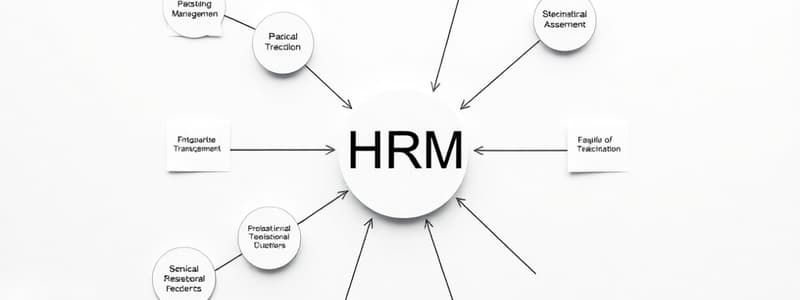Podcast
Questions and Answers
Which model of human resource management is also known as the matching model or best-fit approach?
Which model of human resource management is also known as the matching model or best-fit approach?
- Michigan Model (correct)
- Contingency Model
- Systems Model
- Harvard Model
What is a key feature of the Michigan Model?
What is a key feature of the Michigan Model?
- Focus on employee satisfaction
- Recognition of multiple stakeholders
- Development of transformative policies
- Emphasis on recruitment and selection (correct)
Which leadership style is primarily associated with the Michigan Model?
Which leadership style is primarily associated with the Michigan Model?
- Transformational leadership
- Autocratic leadership (correct)
- Servant leadership
- Democratic leadership
What does the Harvard Model emphasize in human resource management?
What does the Harvard Model emphasize in human resource management?
In the Michigan Model, employees are viewed primarily as what?
In the Michigan Model, employees are viewed primarily as what?
Who developed the Harvard Model of HRM?
Who developed the Harvard Model of HRM?
What aspect is prioritized in the Michigan Model's approach to HRM?
What aspect is prioritized in the Michigan Model's approach to HRM?
What does the Harvard Model recognize about stakeholders?
What does the Harvard Model recognize about stakeholders?
What defines a system in the context of management?
What defines a system in the context of management?
What is a key premise of General Systems Theory?
What is a key premise of General Systems Theory?
Which analogy is used to explain the idea that the whole is greater than the sum of its parts?
Which analogy is used to explain the idea that the whole is greater than the sum of its parts?
In the context of HRM, what does the term 'sociotechnical system' refer to?
In the context of HRM, what does the term 'sociotechnical system' refer to?
What is the role of Human Resource Management (HRM) within an organization according to the systemic approach?
What is the role of Human Resource Management (HRM) within an organization according to the systemic approach?
Which of the following best describes a model in the context of HRM?
Which of the following best describes a model in the context of HRM?
What is a significant output of a well-functioning organizational system?
What is a significant output of a well-functioning organizational system?
What does the term 'input' refer to in the context of a system?
What does the term 'input' refer to in the context of a system?
Flashcards
System
System
A set of interconnected parts working towards a common goal.
General Systems Theory (GST)
General Systems Theory (GST)
A theory finding common organizing principles across complex systems.
Open System
Open System
An organization that interacts with its environment.
Sociotechnical system
Sociotechnical system
Signup and view all the flashcards
HRM (Human Resource Management)
HRM (Human Resource Management)
Signup and view all the flashcards
Model of HRM
Model of HRM
Signup and view all the flashcards
Whole is greater than the sum of its parts
Whole is greater than the sum of its parts
Signup and view all the flashcards
Inputs, Processes, Outputs
Inputs, Processes, Outputs
Signup and view all the flashcards
HRM Model
HRM Model
Signup and view all the flashcards
Michigan Model (Matching Model)
Michigan Model (Matching Model)
Signup and view all the flashcards
Harvard Model
Harvard Model
Signup and view all the flashcards
Hard HRM
Hard HRM
Signup and view all the flashcards
Soft HRM
Soft HRM
Signup and view all the flashcards
Human Resource Cycle
Human Resource Cycle
Signup and view all the flashcards
Key Principles in HRM
Key Principles in HRM
Signup and view all the flashcards
Stakeholders in HRM
Stakeholders in HRM
Signup and view all the flashcards
Study Notes
Human Resources Management Techniques I
- Professor: Zulema Nacimiento, PhD.
- University: University of Huelva
- Unit: 0-2
Unit 0-2: The Systemic Approach and HRM Models
- This unit focuses on the systemic approach to HRM and various models within the subject.
What is a System?
- A system is a set of interconnected, separate elements working towards a common goal.
- A system (or subsystem) is an organized collection of parts which are integrated in order to accomplish a larger overall goal.
- Systems have inputs, processed through certain steps, to create outputs which combine to meet the desired goal.
General Systems Theory (GST or ST)
- Outlined by Ludwig von Bertalanffy (1968).
- GST's premise: complex systems share organizing principles which can be modeled mathematically.
- GST aims to create a general theory explaining all systems in all fields of science.
- It became a paradigm.
- The basic idea of Systems Theory: 'the whole is greater than the sum of its parts.' A classic example is baking a cake: combining ingredients creates a cake whereas each ingredient on its own is not a cake.
The Organization as an Open System
- Organizations are open systems, meaning they interact with their environments.
- Inputs: Raw materials, human resources, capital, technology, and information.
- Transformation Process: Employees' work activities, management activities, technology, and operations methods.
- Outputs: Products/services, financial results, information, and human results.
- Feedback: The cycle that adjusts the system based on inputs and outputs.
The Organization as a Sociotechnical System
- Organizations are combinations of technology (tasks, equipment) and the social system (interpersonal relationships).
- The two systems constantly interact and influence each other.
HRM as a Central Subsystem in an Enterprise
- HRM is a crucial subsystem in any organization.
- HRM is connected to other subsystems, such as product subsystems, financial subsystems, and marketing subsystems.
Models of HRM
- Models in HRM are prototypes that represent reality.
- In HRM, there are two well-known models: The Michigan Model and the Harvard Model.
HRM Models: The Michigan Model
-
Also known as the 'matching model' or 'best-fit' approach.
-
Developed at the Michigan Business School by Fornbun, Tichy & Devanna in 1984.
-
The model prioritizes a tight fit between HR strategies and the overall business strategies.
-
Emphases the importance of business strategy and ‘matching’ employees to business needs.
-
The HR cycle includes recruitment & selection, performance, rewards and development & training.
-
Focuses on hard HRM (cost-effectiveness, short-term focus, and autocratic leadership styles).
-Advantages: -Cost-effective -Minimal investment in employee development or training -Faster decision-making at the senior management level
-Disadvantages: - Demotivating for employees - High staff absenteeism and turnover due to employee dissatisfaction - Ineffective recruitment practices - Inappropriate consideration of stakeholder interests
-
Key Principles: Emphasizes the human resource cycle: recruitment & selection, performance & monitoring, rewards, and development & training
HRM Models: The Harvard Model
-
Referred to as 'the map of HRM territory'.
-
Postulated by Beer in 1984 at Harvard University.
-
Recognizes the existence of multiple stakeholders in an organization.
-
Focuses on soft HRM (employee participation, long-term view, and democratic leadership style).
-Advantages: - Employee participation, empowerment, and commitment - High productivity and a strong employee-employer relationship - Improved communication and teamwork - Equal opportunities for all individuals
-Disadvantages: - High cost of training for employees - Wage increases to maintain competitiveness - Slower decision-making process
-
HRM is viewed as a set of policy choices (reward/work systems).
-
Focus is on organizational performance and employee well-being.
-
Effective utilization of employees is key.
-
Long-term focus, employee empowerment, delegated roles, and democratic leadership are prioritized.
Michigan and Harvard Models: Aims
- Both models aim to achieve the effective utilization of human resources.
- The key goal is enabling the achievement of organizational objectives.
General Systems Theory Summary
- Introduced in 1968, it's a base for understanding how organizations function because they are made of interconnected units; the whole is greater than the sum of its parts.
- It clarifies how HR can be a central, critical component needed by organizations for efficiency and success.
Studying That Suits You
Use AI to generate personalized quizzes and flashcards to suit your learning preferences.




